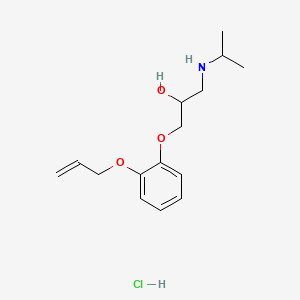



1. Coretal
2. Hydrochloride, Oxprenolol
3. Koretal
4. Oxprenolol
5. Slow Trasicor
6. Tevacor
7. Trasicor
8. Trasicor, Slow
1. 6452-73-9
2. Trasicor
3. Oxprenolol Hcl
4. Evinrozit
5. Ranidrox
6. Rixiprol
7. Coretal
8. Oxprenolol.hcl
9. Ba-39089
10. Ciba 39089ba
11. F4xsi7sniu
12. Oxprenolol (hydrochloride)
13. 2-propanol, 1-(o-allyloxyphenoxy)-3-isopropylamino-, Hydrochloride
14. Ba-39,089
15. 1-(o-allyloxyphenoxy)-3-isopropylamino-2-propanol Hydrochloride
16. 1-(2-(allyloxy)phenoxy)-3-(isopropylamino)propan-2-ol Hydrochloride
17. (+/-)-oxprenolol (hydrochloride)
18. 1-(propan-2-ylamino)-3-(2-prop-2-enoxyphenoxy)propan-2-ol;hydrochloride
19. Secondafil
20. Vrachor
21. Flecor
22. Slow-trasicor
23. Dsstox_cid_1093
24. (+/-)-ba 39089
25. Dsstox_rid_75936
26. Dsstox_gsid_21093
27. Oxiprenolol Hydrochloride
28. Dl-alprenolol Hydrochloride
29. Ccris 1097
30. Unii-f4xsi7sniu
31. C-39089-ba
32. Einecs 229-260-5
33. Einecs 245-358-0
34. Ba 39089
35. (+-)-ba 39089
36. Okuspurecol (tn)
37. Oxprenolol Hydrochloride [usan:usp:jan]
38. Dl-1-(2-allylphenoxy)-3-isopropylaminopropan-2-ol Hydrochloride
39. Ncgc00016675-01
40. 2-(o-allyloxyphenoxy)-2-hydroxy-n-isopropyl-1-propylamine Hydrochloride
41. 2-propanol, 1-(o-(allyloxy)phenoxy)-3-(isopropylamino)-, Hydrochloride, (+-)-
42. Cas-6452-73-9
43. 2-propanol, 1-((1-methylethyl)amino)-3-(2-(2-propenyloxy)phenoxy)-, Hydrochloride
44. 2-propanol, 1-((1-methylethyl)amino)-3-(2-(2-propenyloxy)phenoxy)-, Hydrochloride, (+-)-
45. Mls002154132
46. Schembl123517
47. Chembl1200745
48. Dtxsid5021093
49. Hms1571c16
50. Hy-b1486
51. Tox21_110556
52. Mfcd00058008
53. Oxprenolol Hydrochloride [mi]
54. Oxprenolol Hydrochloride (jp17/usp)
55. Oxprenolol Hydrochloride [jan]
56. (1)-(3-(2-(allyloxy)phenoxy)-2-hydroxypropyl)isopropylammonium Chloride
57. Akos015994696
58. Tox21_110556_1
59. Ccg-221057
60. Ks-1152
61. Oxprenolol Hydrochloride [usan]
62. 1-[(1-methylethyl)amino]-3-{[2-(prop-2-en-1-yloxy)phenyl]oxy}propan-2-ol Hydrochloride
63. Ncgc00179342-03
64. Oxprenolol Hydrochloride [usp-rs]
65. Oxprenolol Hydrochloride [who-dd]
66. 22972-97-0
67. Smr001233439
68. Db-054683
69. Cs-0013185
70. Ft-0630349
71. Sw219956-1
72. Oxprenolol Hydrochloride [ep Impurity]
73. Oxprenolol Hydrochloride [orange Book]
74. D01806
75. Oxprenolol Hydrochloride [usp Impurity]
76. Oxprenolol Hydrochloride [usp Monograph]
77. Sr-01000841263
78. Sr-01000841263-2
79. Q27277643
80. Oxprenolol Hydrochloride 1.0 Mg/ml In Methanol (as Free Base)
81. 1-(2-(allyloxy)phenoxy)-3-(isopropylamino)propan-2-ol Hcl
82. 1-(isopropylamino)-2-hydroxy-3-[o-(allyloxy)phenoxy]propane Hydrochloride
83. 1-[(1-methylethyl)amino]-3-[2-(2-propen-1-yloxy)phenoxy]-2-propanol Hydrochloride
84. 1-[(1-methylethyl)amino]-3-[2-(2-propenyloxy)phenoxy]-2-propanol Hydrochloride
85. 2-propanol, 1-[(1-methylethyl)amino]-3-[2-(2-propen-1-yloxy)phenoxy]-, Hydrochloride (1:1)
| Molecular Weight | 301.81 g/mol |
|---|---|
| Molecular Formula | C15H24ClNO3 |
| Hydrogen Bond Donor Count | 3 |
| Hydrogen Bond Acceptor Count | 4 |
| Rotatable Bond Count | 9 |
| Exact Mass | 301.1444713 g/mol |
| Monoisotopic Mass | 301.1444713 g/mol |
| Topological Polar Surface Area | 50.7 Ų |
| Heavy Atom Count | 20 |
| Formal Charge | 0 |
| Complexity | 246 |
| Isotope Atom Count | 0 |
| Defined Atom Stereocenter Count | 0 |
| Undefined Atom Stereocenter Count | 1 |
| Defined Bond Stereocenter Count | 0 |
| Undefined Bond Stereocenter Count | 0 |
| Covalently Bonded Unit Count | 2 |
Adrenergic beta-Antagonists
Drugs that bind to but do not activate beta-adrenergic receptors thereby blocking the actions of beta-adrenergic agonists. Adrenergic beta-antagonists are used for treatment of hypertension, cardiac arrhythmias, angina pectoris, glaucoma, migraine headaches, and anxiety. (See all compounds classified as Adrenergic beta-Antagonists.)
Anti-Anxiety Agents
Agents that alleviate ANXIETY, tension, and ANXIETY DISORDERS, promote sedation, and have a calming effect without affecting clarity of consciousness or neurologic conditions. ADRENERGIC BETA-ANTAGONISTS are commonly used in the symptomatic treatment of anxiety but are not included here. (See all compounds classified as Anti-Anxiety Agents.)
Anti-Arrhythmia Agents
Agents used for the treatment or prevention of cardiac arrhythmias. They may affect the polarization-repolarization phase of the action potential, its excitability or refractoriness, or impulse conduction or membrane responsiveness within cardiac fibers. Anti-arrhythmia agents are often classed into four main groups according to their mechanism of action: sodium channel blockade, beta-adrenergic blockade, repolarization prolongation, or calcium channel blockade. (See all compounds classified as Anti-Arrhythmia Agents.)
Vasodilator Agents
Drugs used to cause dilation of the blood vessels. (See all compounds classified as Vasodilator Agents.)
Antihypertensive Agents
Drugs used in the treatment of acute or chronic vascular HYPERTENSION regardless of pharmacological mechanism. Among the antihypertensive agents are DIURETICS; (especially DIURETICS, THIAZIDE); ADRENERGIC BETA-ANTAGONISTS; ADRENERGIC ALPHA-ANTAGONISTS; ANGIOTENSIN-CONVERTING ENZYME INHIBITORS; CALCIUM CHANNEL BLOCKERS; GANGLIONIC BLOCKERS; and VASODILATOR AGENTS. (See all compounds classified as Antihypertensive Agents.)
Sympatholytics
Drugs that inhibit the actions of the sympathetic nervous system by any mechanism. The most common of these are the ADRENERGIC ANTAGONISTS and drugs that deplete norepinephrine or reduce the release of transmitters from adrenergic postganglionic terminals (see ADRENERGIC AGENTS). Drugs that act in the central nervous system to reduce sympathetic activity (e.g., centrally acting alpha-2 adrenergic agonists, see ADRENERGIC ALPHA-AGONISTS) are included here. (See all compounds classified as Sympatholytics.)